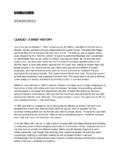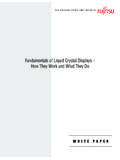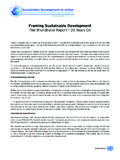Transcription of Meeting on Guidance for standard setting ICP EHH 018 VD96
1 EXECUTIVE SUMMARY Assessment of the health risk of dioxins: re-evaluation of the Tolerable Daily Intake (TDI) WHO Consultation May 25-29 1998, Geneva, Switzerland WHO European Centre for Environment and Health International Programme on Chemical Safety 2 INTRODUCTION Polychlorinated dibenzodioxins (PCDDs), polychlorinated dibenzofurans (PCDFs) and polychlorinated biphenyls (PCBs) constitute a group of persistent environmental chemicals. A number of dioxin or furan congeners, as well as some co-planar PCBs have been shown to exert a number of toxic responses similar to those of 2,3,7,8-tetrachlorodibenzo-p-dioxin (TCDD), the most toxic dioxin. These effects include dermal toxicity, immunotoxicity, reproductive effects and teratogenicity, endocrine disruption and carcinogenicity. During the last years the WHO European Centre for Environment and Health (WHO-ECEH) has been coordinating a comprehensive programme in collaboration with the International Programme on Chemical Safety (IPCS) on PCDDs, PCDFs and PCBs, aiming at evaluating the possible health risk, and prevention and control of environmental exposure of the general population to these chemicals.
2 Several WHO meetings in the field of the health risk assessment of dioxins and related compounds have been convened. At a Meeting held in Bilthoven, The Netherlands (December 1990), a tolerable daily intake (TDI) of 10 pg/kg for TCDD was established. Since then new toxicological, epidemiological and mechanistic data have emerged, in particular with respect to neurodevelopmental, reproductive and endocrine effects. Therefore, WHO-ECEH and IPCS jointly organized a consultation on the Assessment of the health risk of dioxins: re-evaluation of the Tolerable Daily Intake (TDI). The consultation was held from 25-29 May 1998 at WHO Headquarters, Geneva, Switzerland, and was attended by 40 experts from Australia, Belgium, Canada, Denmark, Finland, Germany, Italy, Japan, The Netherlands, New Zealand, Spain, Sweden, United Kingdom, and USA and by staff from UNEP, IARC, IPCS and WHO-ECEH. Dr John Christian Larsen was elected chairman and Dr William Farland co-chair, Dr Mark Feeley and Professor Dieter Schrenk were elected co-rapporteurs, Drs van Leeuwen and Maged Younes were joint scientific secretary.
3 Financial support was provided by the German Ministry of the Environment, The Netherlands Ministry of Health, Well-being and Sports, and Health Canada. As a basis for the discussion during the Consultation, working papers were prepared in advance of the Meeting on: the health risks for infants, cancer and non-cancer endpoints in humans and animals, mechanistic aspects, toxicokinetics, modeling, exposure, the applicability of the TEQ concept, and risk assessment approaches for dioxins in various countries. The Meeting was opened by Dr Leeuwen (WHO-ECEH) who welcomed the participants and presented the objective of this joint ECEH/IPCS Meeting : the health risk assessment of dioxins considering both classical risk assessment methodologies and probabilistic risk assessment approaches, with a view to establishing a TDI for dioxins. He stressed the importance of a thorough, scientific evaluation of all available data and underlined the need for transparency in the derivation of a TDI.
4 Dr M. Mercier (Director IPCS) welcomed the participants to WHO Headquarters and expressed his appreciation for the close collaboration between WHO-ECEH and IPCS in this matter. He noted that the risk assessment of dioxins is a global effort rather than just a European endeavour, as could also be seen from the geographical 3representation of the experts, and he expressed his confidence in the scientific expertise of the participants of the Meeting to carry out the important task they had been given. EXPOSURE Background exposure Human exposure to PCDDs, PCDFs, and PCBs may occur through background (environmental) exposure, and accidental and occupational contamination. Over 90 percent of human background exposure is estimated to occur through the diet, with food from animal origin being the predominant source. PCDD and PCDF contamination of food is primarily caused by deposition of emissions from various sources ( waste incineration, production of chemicals) on farmland and waterbodies followed by bioaccumulation up terrestrial and aquatic foodchains.
5 Other sources may include contaminated feed for cattle, chicken and farmed fish, improper application of sewage sludge, flooding of pastures, waste effluents and certain types of food processing. The available information derived from numerous studies in industrialized countries indicates a daily intake of PCDDs and PCDFs in the order of 50-200 pg I-TEQ/person/day, or 1-3 pg I-TEQ/kg bw/day for a 60 kg adult. This results in average human background levels in the range of 10-30 pg I-TEQ/g lipid, equivalent to a body burden of 2-6 ng I-TEQ/kg body weight. If the dioxin-like PCBs (non-ortho and mono-ortho PCBs) are also considered, the daily TEQ intake can be a factor of 2-3 higher. Special consumption habits, particularly one low in animal fat or consumption of highly contaminated food stuffs may lead to lower or higher TEQ intake values, respectively. The intake of PCDDs/PCDFs and PCBs increases during childhood and stabilizes in adults of about 20 years of age.
6 However, the intake on a per kilogram basis decreases in this period due to the increasing body weight. Despite differences in the absolute levels of PCDDs/PCDFs/PCBs, the congener profiles caused by background contamination are usually very similar. Recent studies from countries which started to implement measures to reduce dioxin emissions in the late 80s, such as The Netherlands, United Kingdom and Germany, clearly show decreasing PCDD/PCDF and PCB levels in food and consequently a significantly lower dietary intake of these compounds by almost a factor of 2 within the past 7 years. Compared to adults, the daily intake of PCDDs/PCDFs and PCBs for breast fed babies is still 1-2 orders of magnitude higher on a per body weight basis. The latest WHO field study showed differences between the PCDD/PCDF and PCB contamination of breast milk, with higher mean levels in industrialized areas (10-35 pg I-TEQ/g milk fat) and lower mean levels in developing countries (< 10 pg I-TEQ/g milk fat).
7 Within one country an individual variation of a factor of 5-10 was observed for most congeners, mainly due to age of the mother, number of breastfed babies, length of nursing period and consumption habits. There is now clear evidence of a decrease in PCDD/PCDF levels in human milk over time in almost every region for which suitable data exist. The WHO field study also showed that the highest rates of decrease have been in the areas with the highest initial concentrations. Latest results from Germany revealed a decrease of PCDD/PCDF levels in human milk of 4approximately 65% between 1989 and 1997. These data support the substantial reduction in intake of PCDDs and PCDFs in the past few years. Accidental exposure Well-known examples of accidental exposure of the local population to PCDDs, PCDFS and PCBs include the incident at Seveso, and fires in PCB filled electrical equipment. In Seveso, the serum levels for 2,3,7,8-TCDD ranged up to 56000 pg/g lipid, with median levels of 450 pg/g lipid for Zone A and 126 pg/g lipid for Zone B.
8 High exposure may also be caused by food items accidentally contaminated. Known examples are the contamination of edible oil, such as the Yusho (Japan) and Yu-Cheng (Taiwan) food poisoning. For a group of Yusho patients, average intake by ingestion of the Kanemi rice oil contaminated with PCBs, PCDFs and polychlorinated quarterphenyls (PCQs) was estimated at 154000 pg I-TEQ/kg bw/day, which is five orders of magnitude higher than the reported average background intake in several countries. Occupational exposure Industrial activities in which 2,3,7,8-TCDD and related compounds are unintentionally produced, such as waste incineration or production of certain pesticides or chemicals may also result in additional human exposure. While many industrial sources of 2,3,7,8-TCDD and related compounds have been identified and worker exposure has been reduced or eliminated historic median 2,3,7,8-TCDD levels in blood of highly exposed workers, estimated by extrapolation back to the time of last exposures, ranged from 140 to 2000 pg/g lipid.
9 These estimates are 1-3 orders of magnitude higher than the blood levels measured in the general population. Body burdens caused by accidental or occupational exposure show congener patterns that are different from background exposure and are normally dominated by only a few congeners. This is because of direct exposure vs. indirect exposure through the food supply where bioaccumulation may modify congener patterns. MECHANISM OF ACTION A broad variety of data primarily on TCDD but also on other members of the class of dioxin-like compounds has shown the importance of the Ah (dioxin) receptor in mediating the biological effects of dioxin. These data have been collected in many experimental models in multiple species including humans. The precise chain of molecular events by which the ligand-activated receptor elicits these effects is not yet fully understood. However, alterations in key biochemical and cellular functions are expected to form the basis for dioxin toxicity.
10 Pharmacological structure-activity and mouse genetic studies using Ah receptor-deficient animals and cells have demonstrated a key role for the receptor in mediating toxic effects of TCDD. For instance, a reduction or lack of acute toxicity in receptor-deficient mice has been documented. The activated receptor exerts two major types of functions: enhancement of transcription of a battery of genes containing responsive elements in their promoter regions, and immediate activation of tyrosine kinases. A number of genes encoding drug-metabolizing enzymes, such as cytochrome P4501A1, 1A2, 1B1, glutathione S-transferase, and UDP-glucuronosyltransferase are members of an Ah receptor target gene battery. Alteration of expression of other networks of genes may be directly or indirectly regulated by the Ah receptor. Activation of the receptor by a ligand can result in endocrine and paracrine disturbances and alterations in cell functions including growth and 5differentiation.














